Submerged healing transforms mobility challenges through water’s unique properties. You’ll benefit from hydrostatic pressure reducing swelling while buoyancy decreases joint stress, allowing freer movement. Warm water therapy relaxes muscles and increases blood flow, creating an ideal environment for rebuilding strength and coordination. The supportive aquatic setting helps you overcome psychological barriers while enhancing cardiovascular efficiency without high-impact stress. Discover how personalized underwater techniques can reconnect you with your body’s full potential.
Understanding Submerged Healing in Mobility Rehabilitation
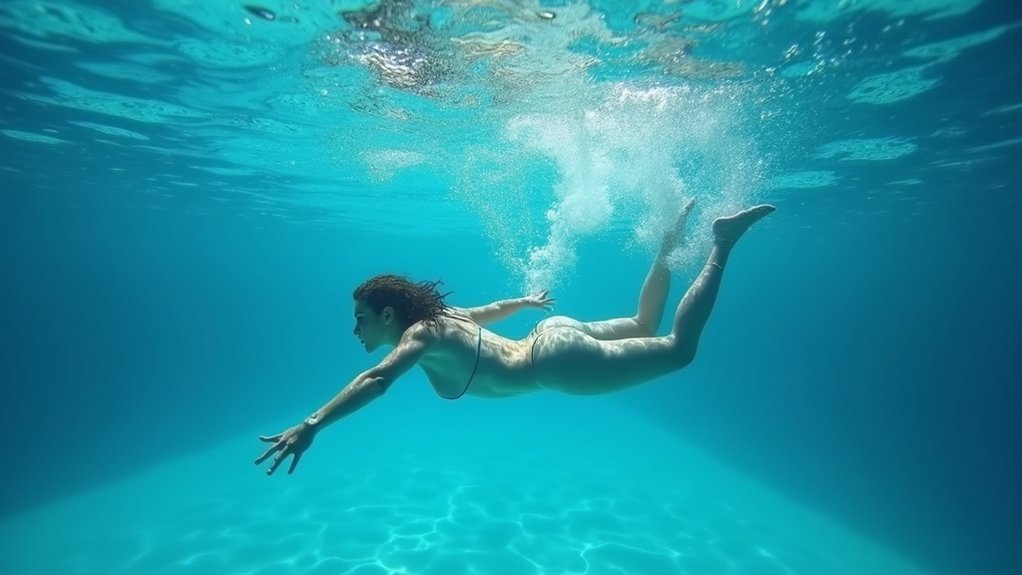
Why does water provide such remarkable healing properties for those with mobility challenges?
It’s all about physics working in your favor. Hydrostatic pressure actively reduces swelling by enhancing circulation, while buoyancy notably decreases joint stress, allowing you to move more freely with less pain.
The integration of warm water therapy promotes muscle relaxation and increases blood flow to injured areas, speeding recovery time.
When you’re submerged, the supportive aquatic environment helps retrain your walking gait in a low-impact setting—ideal if you’re recovering from injury or surgery.
You’ll experience improved body awareness as water resistance enhances proprioception and coordination.
The benefits extend beyond physical rehabilitation; your cardiovascular system strengthens through exercises that would be difficult or painful on land.
This thorough approach makes submerged healing particularly effective for rebuilding mobility while protecting your body from the strain of traditional therapy methods.
The Science Behind Water-Based Therapy for Limited Mobility
When you enter a therapy pool, your body immediately experiences a transformation governed by fundamental physical principles. Buoyancy supports your weight, reducing stress on painful joints while hydrostatic pressure works to decrease swelling and improve circulation throughout your body.
The science behind aquatic therapy’s effectiveness lies in three key mechanisms:
Aquatic therapy works through physical properties, physiological responses, and neurological benefits—science that transforms healing when traditional approaches fall short.
- Physical properties – Water’s natural resistance strengthens your muscles without the harsh impact experienced during land-based exercises.
- Physiological responses – Warm water increases blood flow to injured areas, promoting healing while simultaneously reducing pain signals.
- Neurological benefits – The supportive aquatic environment enhances proprioception and balance, allowing your nervous system to relearn movement patterns with reduced fear of falling.
This combination creates an ideal environment for rebuilding mobility when traditional therapy proves challenging. Water therapy has been consistently beneficial for diverse populations, particularly showing effectiveness in neurological injuries and rehabilitation processes.
Key Benefits of Underwater Movement for Joint Recovery
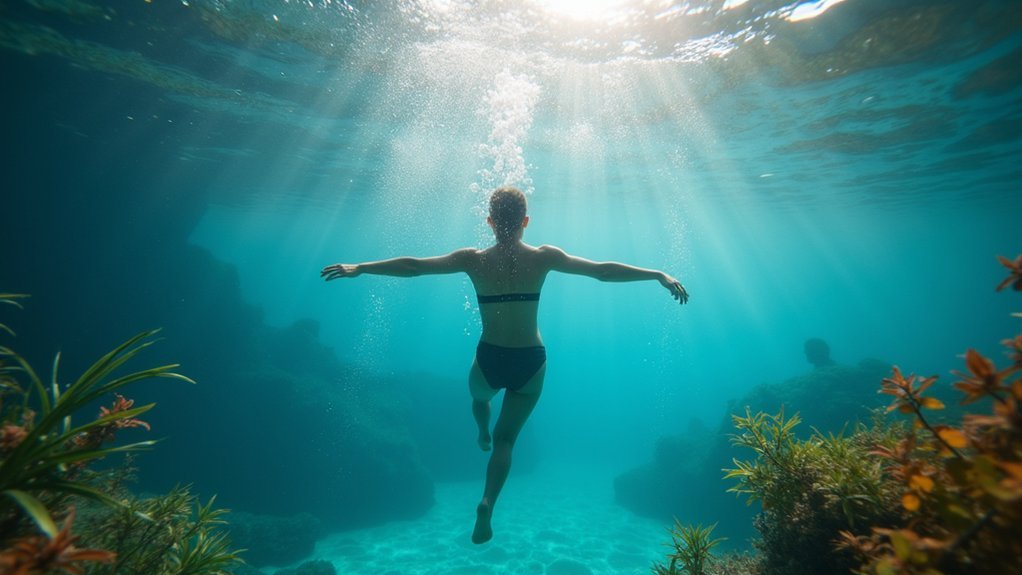
Underwater movement offers transformative benefits for those recovering from joint injuries or conditions.
When you’re immersed in water, buoyancy immediately reduces stress on your painful joints, allowing you to exercise with minimal discomfort. You’ll notice improved range of motion as water’s warmth relaxes tight muscles and reduces friction that typically limits movement.
The hydrostatic pressure works to decrease inflammation while supporting your body, enabling movements that might be impossible on land. Starting aquatic therapy six weeks before surgery can significantly improve your post-operative outcomes. You can strengthen essential stabilizing muscles without aggravating your condition.
For post-surgery recovery, aquatic therapy accelerates healing by permitting early mobilization in a safe environment. The psychological boost is significant too—you’ll regain confidence in your mobility as you perform exercises with less pain and fear of falling.
Adapting Swimming Techniques for Various Physical Limitations
You’ll find that water’s natural buoyancy creates an ideal environment for customizing swimming techniques to your specific physical limitations.
Movement adaptations underwater can reduce strain on affected joints while still providing effective resistance for strength building.
For individuals with disabilities, accessible adaptations are available that maintain the cardiovascular benefits while accommodating different levels of mobility and strength.
Therapeutic water exercises, when tailored to your particular mobility challenges, can transform standard swimming strokes into powerful rehabilitation tools that improve your range of motion and confidence.
Movement Adaptations Underwater
Swimming offers unique freedom for individuals with mobility challenges, but mastering proper movement adaptations underwater is essential for both safety and therapeutic benefit.
You’ll find that water’s buoyancy creates an ideal environment for modified techniques that accommodate your specific limitations.
When adapting your swimming technique, consider:
- Stroke Selection – Choose breaststroke for upper body limitations, backstroke for lower back issues, or modified freestyle for shoulder constraints.
- Body Positioning – Maintain streamlined positioning to reduce drag, increasing your efficiency while conserving energy.
- Progressive Training – Start with flotation devices if needed, then gradually incorporate resistance training to build strength while respecting your body’s limitations.
The elementary backstroke provides extended swimming duration with minimal fatigue, making it ideal for those with energy-limiting conditions.
Understanding hydrodynamics and implementing personalized modifications will transform your aquatic experience from challenging to therapeutic, allowing you to move with greater confidence and less pain.
Buoyancy Assists Recovery
Buoyancy represents a fundamental force in aquatic therapy, offering remarkable benefits for those with mobility limitations. When you enter water, your body experiences immediate joint relief as gravitational forces decrease, allowing you to move with reduced pain and greater freedom.
You’ll find that hydrostatic pressure enhances muscle activation while simultaneously providing gentle resistance for strength building. This unique environment allows you to achieve improved range of motion that might be impossible on land.
For personalized recovery, you can utilize adaptive techniques like pull buoys for stability or arm isolation drills that accommodate your specific abilities. Practicing proper breath control techniques is essential for maximizing the therapeutic benefits of aquatic exercises.
Equipment such as flotation belts and underwater treadmills further customize your experience, creating a safe space to regain confidence in movement while minimizing fall risks and joint stress.
Therapeutic Water Exercises
When adapted for individual needs, therapeutic water exercises can transform conventional swimming techniques into powerful rehabilitation tools for those with physical limitations.
Whether you’re managing a neurological condition like Parkinson’s or recovering from orthopedic injuries, water’s buoyancy creates an ideal environment for movement without excessive strain.
You’ll experience notable benefits through modified swimming techniques:
- Enhanced motor control – Breaststroke and freestyle adaptations improve coordination while strengthening muscles around affected joints.
- Reduced muscle tension – Warm water facilitates relaxation, decreasing muscle spasms and hypertonicity.
- Improved balance stability – Water’s continuous motion challenges your postural control systems without fall risks.
These exercises not only strengthen your body but also boost confidence in a supportive setting where you can safely practice movements that might be impossible on land. Techniques like Ai Chi combine deep breathing with gentle movements to achieve a meditative state while improving flexibility.
Specialized Equipment for Effective Submerged Therapy Sessions
Why does specialized equipment make such a profound difference in aquatic therapy outcomes?
It’s because the right tools transform water from a simple medium into a sophisticated therapeutic environment tailored to your specific needs.
Underwater treadmills and bicycles provide cardiovascular benefits while eliminating joint stress.
Resistance jets and adjustable water depth systems allow your therapist to precisely calibrate resistance levels as you progress.
For those with mobility challenges, overhead hoists, supportive rails, and graduated stair systems guarantee safe entry and exit.
Advanced monitoring equipment, including underwater cameras, gives you immediate visual feedback while tracking your progress.
Buoyancy equipment—from belts to foam collars—provides the perfect balance of support and challenge, while specialized tools like aquatic dumbbells and resistance bands build strength in a gentle, controlled environment.
The heated water temperature of 88°F to 94°F creates an ideal environment for muscle relaxation and pain reduction during therapy sessions.
Creating an Accessible Aquatic Environment for All Abilities
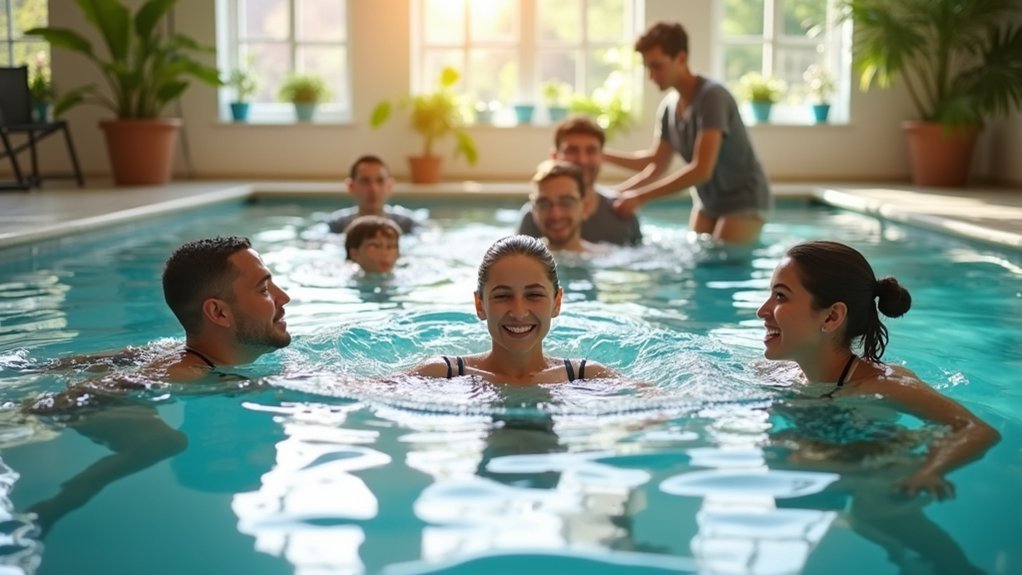
When designing an accessible aquatic facility, you’ll need to incorporate universal pool design elements like zero-depth entries and appropriate lane widths to accommodate users of all abilities.
Adaptive water entry solutions, including ADA-compliant pool lifts and sloped entries, guarantee everyone can safely access therapeutic benefits without barriers.
Your facility should also feature specialized therapeutic equipment such as underwater treadmills and resistance tools that maximize rehabilitation potential while supporting independence for individuals with mobility challenges. Staff members should receive comprehensive training to assist patrons with disabilities in using accessibility equipment properly.
Universal Pool Design Elements
Creating truly accessible aquatic environments requires thoughtful integration of universal design principles that serve people of all abilities.
When designing pools that accommodate everyone, you’ll need to take into account both structural elements and user experience factors simultaneously. Implementing color contrasting tiles at pool edges significantly improves navigation and safety for users with visual impairments.
Effective universal pool design incorporates:
- Flexible configurations with movable lane lines and variable depths that allow for different activities from therapy sessions to recreational swimming.
- Accessible entry points including zero-depth entries, transfer walls, and pool lifts that enable dignified access regardless of mobility level.
- Thoughtful material selection featuring slip-resistant surfaces around the pool perimeter and in changing areas to prevent accidents and enhance confidence.
These design elements don’t just meet ADA compliance—they create environments where therapeutic benefits become accessible to everyone, regardless of physical limitations.
Adaptive Water Entry Solutions
While universal design principles establish the foundation for inclusive aquatic spaces, practical implementation hinges on specific equipment and infrastructure that allow everyone to enter the water safely and with dignity.
You’ll find that adaptive water entry solutions—including ramps, lifts, and transfer systems—create smooth, unobstructed pathways that benefit users of all abilities.
These solutions aren’t just accommodations; they’re investments that transform communities. With costs typically less than 3% of total project expenditures, accessible water facilities deliver exceptional value while promoting inclusion.
When you implement accessible launches, you’ll see increased visitation—some locations report threefold increases—and economic benefits as paddlers typically spend $55 per visit in local economies.
Therapeutic Aquatic Equipment
The foundation of effective aquatic therapy lies in specialized equipment designed to harness water’s natural properties for rehabilitation.
These tools transform ordinary pools into healing environments where you’ll experience reduced joint impact while rebuilding strength and mobility. The buoyancy of water supports up to 50% of your body weight, dramatically reducing stress on healing joints during therapy sessions.
Your therapeutic journey benefits from thoughtfully designed equipment that addresses specific rehabilitation needs:
- Resistance tools – Underwater treadmills, stationary bikes, and resistance bands provide customizable challenges that strengthen muscles without overwhelming them.
- Buoyancy aids – Pool noodles and specialized flotation devices support your body, making movements possible that might be impossible on land.
- Accessibility features – Hydraulic lifts, multi-depth pools, and adjustable water currents guarantee therapy remains accessible regardless of your mobility limitations.
This specialized equipment creates an environment where healing becomes possible through the unique properties of water.
Success Stories: Transformative Healing Through Water Therapy
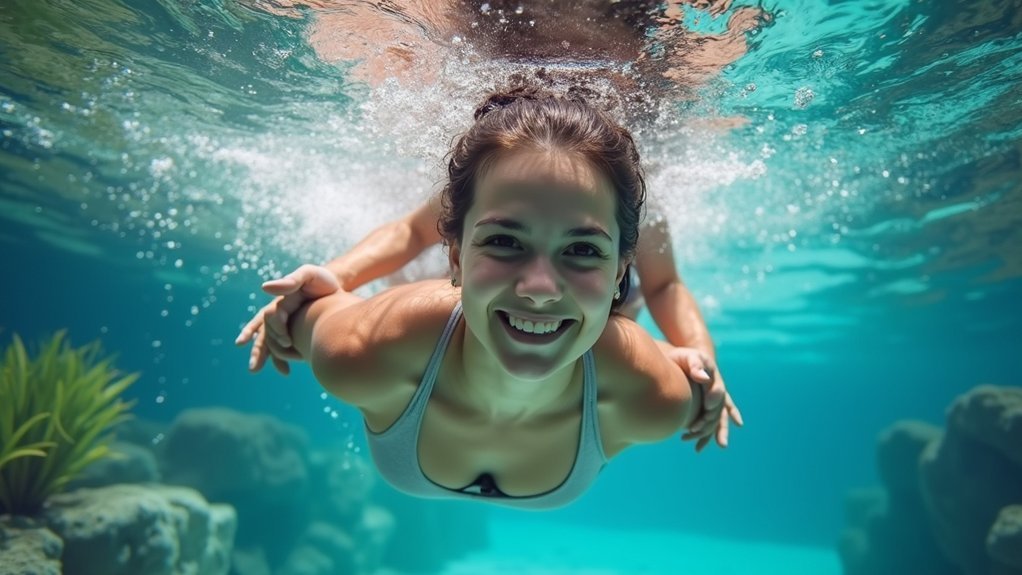
Remarkable stories of recovery emerge daily from aquatic therapy centers worldwide, where patients with diverse mobility challenges find new pathways to healing.
You’ll witness the transformative impact across various conditions, from cerebral palsy to post-surgical recovery. In the water, patients with Parkinson’s regain balance while those with chronic back pain find relief through buoyancy’s gentle support.
The hydrostatic pressure reduces swelling, allowing earlier rehabilitation than traditional methods permit.
Beyond physical improvements, you’ll notice psychological transformations as well. Patients build confidence with each achievement, developing emotional resilience through successful movement experiences. Licensed professionals with specialized aquatic training create personalized programs that address individual needs.
The warm, supportive environment promotes stress reduction while improving body awareness.
These success stories consistently demonstrate that aquatic therapy offers thorough healing—addressing both physical limitations and psychological barriers that often accompany mobility challenges.
Professional Guidance: Working With Aquatic Rehabilitation Specialists
Effective aquatic rehabilitation hinges on expert guidance from certified specialists who bring extensive knowledge to your healing journey. These professionals hold certifications in physical therapy or related fields, ensuring your treatment is evidence-based and tailored to your specific mobility challenges.
When working with an aquatic rehabilitation specialist, you’ll benefit from their:
- Thorough evaluation process that assesses your unique needs and establishes clear therapeutic goals
- Deep understanding of water’s physical properties and how they can be leveraged for your particular condition
- Ability to collaborate with other healthcare providers, creating an integrated approach to your recovery
Your specialist will continually monitor your progress, adjust techniques based on your response, and implement strict safety protocols throughout your rehabilitation experience. Qualified practitioners are trained in essential first aid and CPR to ensure maximum safety during your aquatic therapy sessions.
Overcoming Fear and Building Confidence in Water-Based Recovery
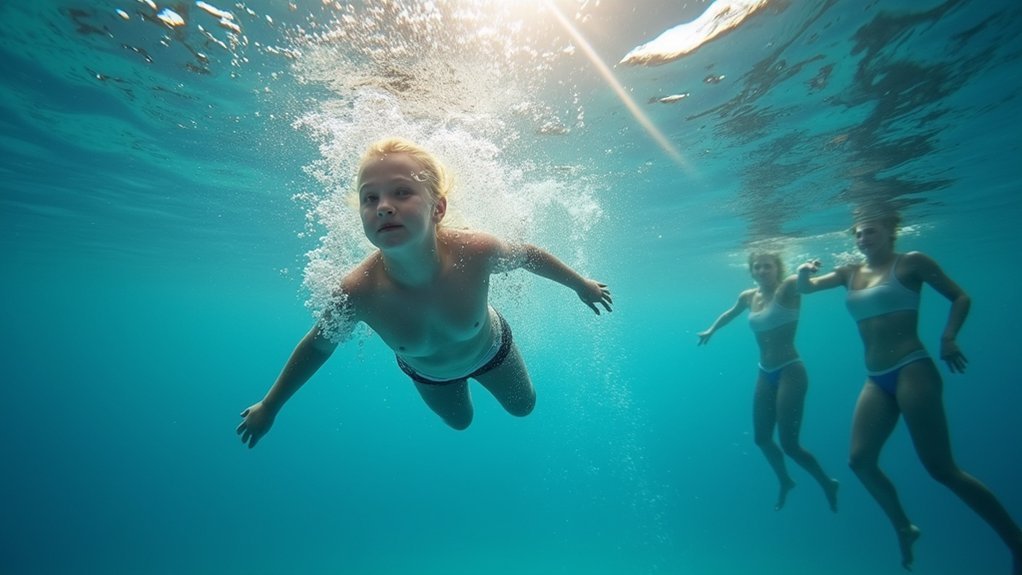
You’ll often face mental barriers that outweigh physical limitations when beginning water therapy for mobility challenges.
The natural buoyancy of water creates a supportive environment where your body feels lighter, helping transform initial fear into newfound confidence.
This psychological shift occurs as you experience successful movements in water that might seem impossible on land, gradually rebuilding your belief in your body’s capabilities. The warm water environment promotes deep relaxation and reduces muscle tension, further enhancing your emotional readiness to attempt new movements.
Psychological Barriers Underwater
While water offers an ideal environment for rehabilitation, many patients face significant psychological barriers when beginning aquatic therapy.
The fear-avoidance model reveals how anticipation of pain can trap you in a cycle of activity avoidance, leading to muscle atrophy and even depression if not addressed.
Your concerns about aquatic therapy typically fall into three categories:
- Fear of pain or injury – particularly common among post-surgery patients who worry about wound safety.
- Environmental anxieties – including water phobia, body image concerns, or worries about facility accessibility.
- Skepticism about effectiveness – often stemming from lack of information about aquatic therapy’s scientific benefits.
Overcoming these barriers requires gradual exposure to water environments, educational materials, and supportive therapists who can guide you through each step of the rehabilitation process. Studies have shown that proper waterproofing techniques can safely allow post-operative patients to benefit from aquatic therapy without increased risk of wound complications.
Confidence Through Buoyancy
Water’s natural buoyancy transforms rehabilitation from a painful struggle into a confidence-building journey for those with mobility challenges.
When you enter the pool, you’ll immediately feel lighter as water supports up to 90% of your body weight, reducing joint strain while strengthening muscles through gentle resistance. The joint mobility benefits allow for easier and less painful movement than would be possible during land-based exercises.
Beyond physical benefits, aquatic therapy nurtures your emotional recovery. The stress-relieving properties of water create an environment where you can rebuild self-esteem while engaging with others in similar situations.
As you master new skills underwater, you’ll experience cognitive improvements in problem-solving and mental clarity.
Every successful movement in water reinforces your capabilities, building a foundation of self-trust that extends beyond the pool.
This newfound confidence becomes the cornerstone of your rehabilitation journey, empowering personal growth and social reintegration.
Healing Mental Limitations
The journey beyond physical limitations begins with conquering the mental barriers that often accompany mobility challenges.
Water-based therapies provide a unique environment where your mind can heal alongside your body.
When you immerse yourself in aquatic therapy, you’ll experience:
- Reduced anxiety and depression – Swimming and water aerobics actively diminish symptoms while enhancing self-esteem and decreasing social stigma.
- Enhanced mindfulness – The water environment keeps you present, resetting emotional responses and building resilience through controlled challenges.
- Cognitive improvement – Combining water aerobics with metacognitive training strengthens brain adaptability and function.
Research shows that gender influences therapeutic outcomes, with men and women reporting different benefits from water-based activities.
Water creates a multisensory experience that promotes neuroplasticity and induces flow states.
This holistic approach to recovery addresses both physical and mental aspects, helping you rediscover joy while building confidence through movement.
Maintaining Progress: From Pool to Daily Mobility Improvements
Successfully altering aquatic therapy benefits to everyday life requires consistent effort and strategic planning.
The buoyancy effect that reduced joint stress in water needs to be gradually replaced by strengthened muscles that can support your daily movements.
Utilize the hydrostatic pressure advantages by maintaining proper circulation through regular movement on land.
Keep blood flowing efficiently by staying active on land, just as water pressure supported circulation during therapy.
Your customized aquatic exercises have prepared your body with increased range of motion and progressive resistance—now apply these gains to everyday activities.
The pain management techniques you’ve learned underwater can translate to stress-free movements in daily life.
Remember that consistency is vital; schedule regular mobility exercises to prevent regression.
As you shift from pool to daily living, pay attention to how your body responds and adjust accordingly.
The improved vascular health and reduced inflammation from water therapy will continue supporting your mobility if you maintain the momentum.
For those who have experienced physical traumas or injuries, aqua therapy provides a unique opportunity for weightlessness and comfort during the critical recovery phase.
Combining Traditional Therapy With Innovative Underwater Approaches
Integrating traditional therapy modalities with underwater approaches creates a powerful synergy that maximizes mobility gains for those facing physical challenges.
You’ll benefit from extensive rehabilitation programs that combine the best of both worlds—leveraging hydrostatic pressure to reduce inflammation while improving strength through aquatic resistance training.
The thermal benefits of water immersion complement your traditional therapy by:
- Increasing blood flow to injured areas while reducing pain that restricts movement
- Allowing effortless exercise through buoyancy, minimizing stress on weakened joints
- Enhancing cardiovascular efficiency without the high-impact stress of land-based therapy
This combined approach guarantees your personalized recovery plan addresses all aspects of mobility, with continuous assessment to adjust techniques as you progress from pool to everyday activities.
Documentary subject Kelsey Peterson demonstrates how water therapy helped reconnect with her body after becoming a C6 quadriplegic from a diving accident.
Measuring Success: Tracking Mobility Gains From Submerged Healing
How do rehabilitation specialists measure the true impact of underwater therapy on physical mobility?
Success evaluation relies on multiple clinical parameters including tissue integration, suppuration levels, and attachment stability.
You’ll find specialists using both traditional and advanced tools like the Osstell device, which measures stability through resonance frequency analysis, and the Periotest device for primary stability assessment.
These provide quantifiable ISQ values to track your progress.
Your rehabilitation team will monitor bone changes through radiographic analysis, with successful submerged healing showing minimal bone loss after initial integration.
Though single-device assessment guarantees consistency, it’s worth noting that clinical parameters don’t always predict future outcomes.
Different healing protocols—submerged or non-submerged—offer varying benefits, with submerged healing providing enhanced stability in a protected environment during your recovery journey.
The study revealed that there exists a moderate negative correlation between ISQ and Periotest values immediately after installation, indicating the complementary nature of these measurement tools.
Frequently Asked Questions
Is Submerged Healing Covered by Most Insurance Plans?
Submerged healing isn’t covered by most standard dental plans as it’s often considered part of implant procedures. You’ll need to check your specific policy terms, as medical insurance may cover it if medically necessary.
Can Patients With Pacemakers Safely Participate in Underwater Therapy?
You can safely participate in underwater therapy with a pacemaker after healing, but you’ll need your doctor’s approval first. Avoid SCUBA diving and stay away from pool chlorination systems that might cause interference.
How Does Chlorine Affect Healing Wounds During Aquatic Therapy?
Chlorine can irritate your healing wounds, slowing recovery and increasing infection risk. You’ll want to use waterproof dressings during aquatic therapy or postpone sessions until your wound has fully closed.
Are There Age Restrictions for Submerged Healing Programs?
You’ll generally need to be at least 18 years old for submerged dental implant healing. While there’s no strict upper age limit, your overall health matters more than your age for eligibility.
Can Submerged Healing Worsen Certain Neurological Conditions?
Yes, submerged healing can worsen neurological conditions if you have decompression illness risks, oxygen toxicity susceptibility, or conditions like PFO. You’ll need proper medical screening before participating to guarantee your safety.
In Summary
You’ve now discovered how underwater therapy can revolutionize your mobility journey. By embracing submerged healing, you’re giving your body the perfect environment to rebuild strength without pain. Don’t wait to experience these benefits—start with small steps in the water and watch as your confidence grows. Your improved mobility isn’t just possible; with consistent underwater work, it’s inevitable.

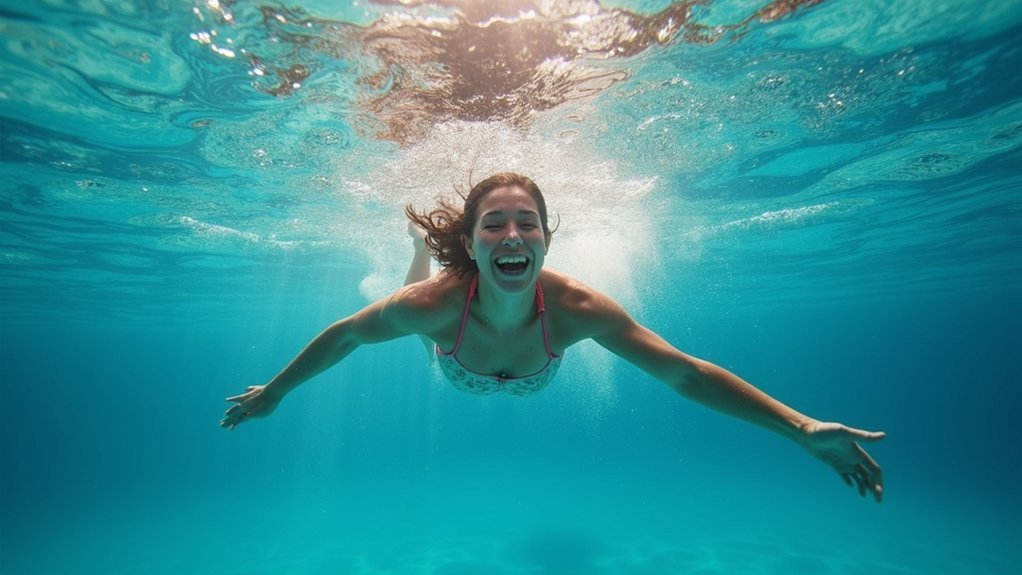



Leave a Reply